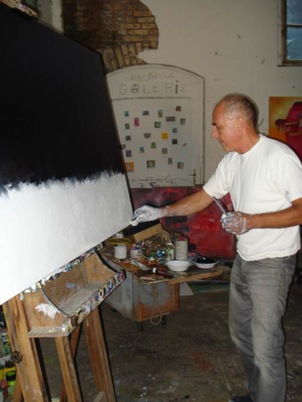
Charles Haldi
Teacher in Bolligen (1982–), including a teaching exchange in Hamilton, Ontario (1998/99); 1976–1981 post-secondary education at the Universities of Bern and Sorbonne, Paris
29 September 1954
Exhibitions
Belle Epoque Bern 14; Kulturtage Bolligen 11; Büner Bern 08; Kunst-Supermarkt Solothurn 05; Works of art for the Insel University Hospital Bern; Neuchâtel-Arts 95; ART for the International School of Berne; Works of art for the International Menuhin Music Academy
Pflatschism
Developed from Art Informel – an art movement that united various groups of artists of non-representational painting. It differentiated from Geometric Abstraction (Mondrian, van Doesburg, Claisse) with its defined forms and outlined composition conventions.
The Art Informel artists created new realities with their paintings. They did not identify with abstractions or just copying the outer world. In contrast to Concrete Art artists (Albers, Lohse, Vasarely, Bill), they renounced mathematical and geometrical concepts and expressed their emotions – hereby influenced by the American Abstract Expressionists (Rothko, Newman, Pollock, Motherwell) – with rhythmically dripped spots of colour and with invented symbols on canvas.
It is certain that towards the end of the 20th century Haldi – at the time still unknown in the wider art community – became one of the most significant representatives of the Art Informel, also known as Tachisme in French (Michaux, Matthieu, Francis, Haldi).
Starting in 2003, Haldi began – at first with hesitation – to turn away from the Art Informel. He continued to explore new paths and finally developed the new art form of Pflatschism – which can be described as a primitive "Pflatschen" of a single shade of colour (or sometimes two shades) on expensive handmade paper.
